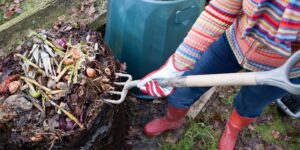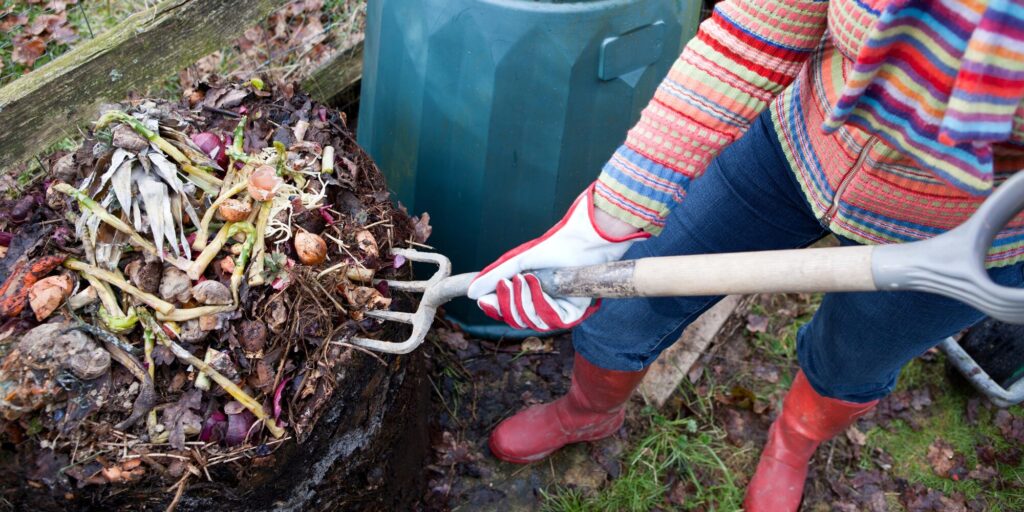At this time of year, if you’ve got a raised bed in your garden for growing vegetables, chances are you follow a “no dig” method of gardening, in which case it’s time to add your new organic layer to bed in before you plant your spring veg. There’s no better way to do this than by using your very own home-grown compost.
Composting is an excellent way to recycle your vegetable peelings, coffee grounds, teabags, and even paper and brown, non-shiny cardboard, with Sellotape and staples removed. You can also add grass cuttings, chicken and rabbit bedding, weeds, and egg-boxes. You’ll be surprised at the power of a compost heap to turn all of this into black gold full of nutrients for your vegetable beds, all while saving tonnes of waste from going into landfill or incineration. If you have a hot compost bin, you can even include raw food waste, cooked food waste, and meat and dairy waste.
To optimise your compost bin, it’s important to keep the humidity at the right level, to include soil matter (ideally your compost bin should be situated on the earth which has been dug over lightly before placing) and in full sun to allow the best decomposition rate. You ought to fork it over regularly, and if it starts to dry out water it either with rainwater or urine (it speeds up the process and adds valuable nitrogen!). To find out more about this process and how to introduce it into your garden, get in touch and I’ll happily help.

To simplify what you can include in your compost bin, here’s a handy list from gardenorganic.co.uk:
‘Greens’ (nitrogen-rich ingredients)
- Grass cuttings
- Young weeds
- Nettles (not roots)
- Comfrey leaves
- Urine (ideally diluted 20:1)
- Uncooked fruit and vegetable peelings
- Tea bags (Many teabags contain small quantities of plastic. Ideally empty bags first and use only the leaves on the compost.) Tea leaves and coffee grounds
- Soft green prunings
- Animal manure from herbivores e.g., cows and horses
- Poultry manure
‘Browns’ (carbon-rich ingredients)
- Cardboard e.g., cereal packets, toilet roll tubes and egg boxes
- Wastepaper and junk mail, including shredded confidential waste
- Paper towels & bags
- Bedding (hay, straw, shredded paper, wood shavings) from vegetarian pets e.g., rabbits and guinea pigs
- Tough hedge clippings
- Woody prunings
- Old bedding plants
- Straw
Other compostable items
- Wood ash, in moderation
- Hair, nail clippings
- Egg shells
- Natural fibres, e.g., wool and cotton
It’s a massive list! Think of all the things you’ve been throwing away that you could, instead, be turning into gorgeous soil improver for your garden. An easy way to collect it is to have a small caddy in your kitchen for food waste such as peelings and coffee/tea, and a small bin for toilet rolls and other suitable paper waste. Chicken and small animal coops/hutches can be shovelled straight into the bin, and garden waste easily collected in a trug as you work.
So, you know what you CAN put in your standard cold compost bin, what about the things you can’t?
- Coal & coke ash
- Cat litter
- Dog faeces
- Disposable nappies
What type of compost bin is best?
You can have a cold compost bin or a hot compost bin. With a hotbin, you can include everything on the list of safe ingredients and add on cooked food waste, raw food waste, (including meat waste) and perennial weeds (which will not die in a cold bin). They are a little pricier than a pallet-constructed option, but considering the amount of waste saved, it is worth the investment.
If you would like assistance to develop your garden design to include a compost bin, I would love to help. Drop me a message and let’s see how we can make your garden more environmentally friendly.

